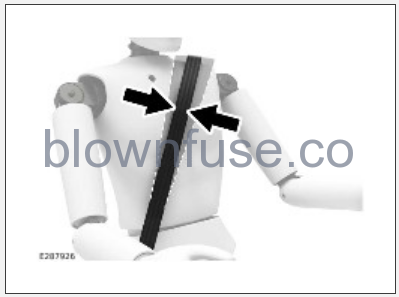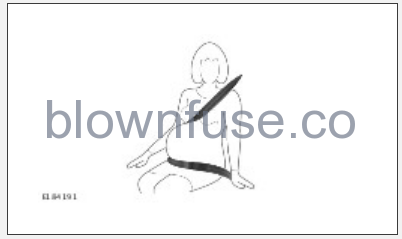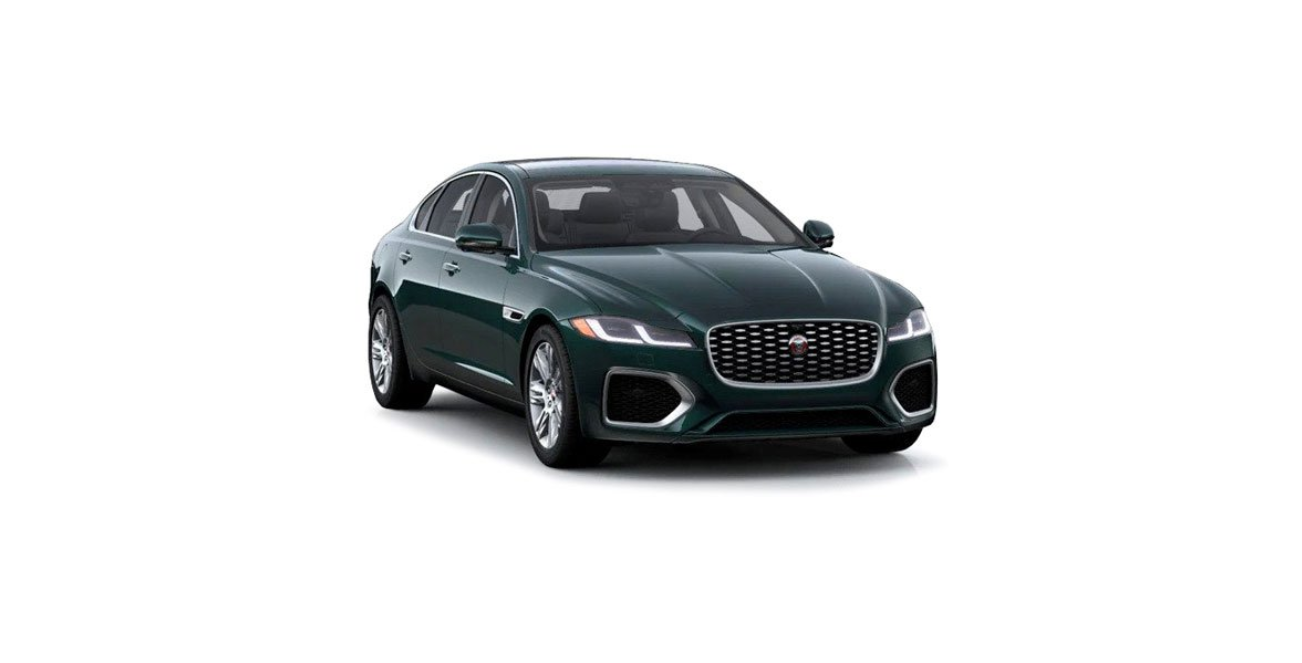
2022 Jaguar XF Seat Belts

SEAT BELT SAFETY
Make sure to read and fully understand the relevant warnings before using any of the features in this section. Failure to observe warnings and cautions may result in vehicle damage, injury, or DEATH in the event of an accident.
- Always replace a seatbelt if it becomes frayed, contaminated, doesn’t work properly or after the vehicle has been involved in an accident.
- Always avoid contamination of the webbing with polishes, oils, chemicals and especially battery acid. Cleaning may safely be carried out using mild soap and water.
- Always make sure the seat belts are not damaged, or exposed to sharp edges when using them to restrain items other than occupants.
- Always wear seat belts low across the front of the pelvis, chest and shoulders.
- Always adjust seatbelts and positioning sliders as firmly as possible, consistent with comfort.
- Always sit well back in the seat, with the seatback in an upright position.
- All occupants should always wear seat belts, for every journey, no matter how short. The air bag Supplementary Restraint System (SRS) adds to the overall effectiveness of the seat belts, but does not replace them.
- Never place anything between the occupant and the seat belt.
- Never use comfort clips, or any devices that create slack in the seat belt system.
- Never modify the seat belt adjusting devices or assembly, in any way that prevents the assembly from being adjusted to remove slack.
- Never wear seat belts with the straps twisted.
- Never place a seat belt around a child being carried on an occupant’s lap. Each belt assembly must only be used by one occupant.
- Never independently wear the lap belt or shoulder belt portion of the seat belt.
- Never attempt to cushion the impact of an accident by placing anything between an occupant and the seat belt.
- Make sure the seat belts are correctly routed and not trapped behind the seats when raising the rear seatbacks.
- Always make sure the correct buckle for the seating position is selected.
Always contact a retailer / authorized repairer before attempting to carry out a repair on a vehicle. Only approved replacement parts should be used for any repairs that are carried out.
SEAT BELT OPERATION
A seat belt slider may be fitted to this vehicle. When the seat belt is not in use, the belt slider allows for optimal positioning of the metal tongue.
Each seat in the vehicle has a dedicated seat belt, designed for an occupant older than 12 years of age or weighing more than 80 lb (36 kg). Occupants with a lower age, or a lower body mass, should use an appropriate child restraint.
1. Make sure that the seat, and occupant’s sitting position, are correct.
2. Draw the belt out smoothly across the collar bone at the mid-point between the shoulder and neck, and down to the appropriate buckle.

3. Press the metal tongue into the buckle until a click is heard.
1. Hold the belt.
2. Press the red button on the buckle.
3. Guide the seat belt back to its original resting position.
When releasing the seat belt, hold the belt before pressing the release button. Doing so prevents the belt from retracting too quickly.
IF A SEAT BELT HEIGHT ADJUSTER IS FITTED, TO OPERATE:
Never attempt to adjust the seat belt height once the vehicle is in motion. Doing so may cause incorrect seat belt adjustment or loss of vehicle control.
Always make sure the height is correctly adjusted and the mechanism is locked in place before driving. Maladjustment of the seat belt could reduce its effectiveness in a crash.
1. Press and hold the button to release the locking mechanism.
2. Slide the mechanism up or down to the required height.
3. Release the button to re-engage the locking mechanism.
SEAT BELT USE DURING PREGNANCY
Make sure to read and fully understand the relevant warnings before using any of the features in this section. See SEAT BELT SAFETY.

Always position the seat belt correctly for the safety of a pregnant mother and unborn child. Failure to observe this may increase the risk of serious injury during emergency braking or in the event of an accident.
Never place anything between you and the seat belt in an attempt to cushion the impact in the event of an accident. It can be dangerous and reduce the effectiveness of the seat belt in preventing injury.
To adjust the seat belt for use during pregnancy:
- Position the lap strap comfortably across the hips, beneath the abdomen.
- Place the diagonal part of the seat belt across the chest, and to the side of the abdomen.
SEAT BELT CHECKS
Regularly inspect seat belts for wear and damage. Regularly check for fraying, cuts, or wear to the webbing. Also check the condition and security of the mechanism, buckles, adjusters, and mounting points.
To inspect the condition of the seat belts:
- With the seat belt fastened, give the webbing near the buckle a quick upward pull. The buckle must remain securely locked.
- With the seat belt unfastened, unreel the seat belt to the limit of its travel. Check that it unreels smoothly with no snags. Allow the belt to fully retract with a smooth action.
- Partially unreel the seat belt. Hold the tongue plate and give a quick forward pull. The mechanism must lock and prevent any further unreeling.
If any seat belt fails to meet the above criteria contact a retailer/authorized repairer immediately.
If the vehicle is parked on an incline, the seat belt mechanism may lock. If locking occurs, ease the belt out from the upper anchorage. If the belt does not ease out from the anchorage, return the vehicle to level ground before attempting to release the seat belt again.
If the rear seats are returned to the upright position quickly, the seat belt mechanism may lock. If locking occurs, ease the belt out from the upper anchorage.
SEAT BELT LOCKING MECHANISM
The rear seat belts and the front passenger seat belt have a locking mechanism that improves the retention of child seats.
To fit a child seat:
- Place the child’s seat in the vehicle. Attach the seat belt, and secure the buckle in accordance with the manufacturer’s fitting instructions.
- Pull on the shoulder section of the belt to unreel all of the remaining webbings to the limit of its travel. The automatic locking feature now engages. The locking feature acts as a ratchet, only allowing the webbing to retract.
- Allow the seat belt to retract onto the child seat, while firmly pushing the child seat into the vehicle’s seat. A clicking sound confirms that the ratchet has engaged.
- Make sure there is no slack in the seat belt, by pulling upward on the shoulder belt immediately above the child restraint.
When the child seat is removed, and all of the seat belt webbings is allowed to retract, the seat belt locking mechanism reverts to normal operation.
SEAT BELT REMINDER
Make sure to read and fully understand the relevant warnings before using any of the features in this section. See SEAT BELT SAFETY.
An audible warning sound and a warning lamp illuminate when the following conditions occur:
- The driver seat or the front seats are occupied.
- The front seat belts have not been fastened.
- The vehicle accelerates at a low speed.
- A front seat belt is unfastened while the vehicle is moving.
- A rear seatbelt is unfastened.
If a front seat belt has not been fastened, the audible and visual warnings turn off after a short period of time.
There may be a short delay at the start of the journey before the passenger side reminder operates.
SEAT BELT MONITOR
Make sure to read and fully understand the relevant warnings before using any of the features in this section. See SEAT BELT SAFETY. The instrument panel displays a graphic to indicate which rear seat belts are fastened at the start of a journey. The graphic also indicates when a seat belt is fastened or unfastened during a journey.
In all cases the graphic covers all rear seating positions and may also display front row positions.
SEAT BELT PRE-TENSIONERS
Always check and replace the seat belt pre-tensioners after any activation. Failure to replace the pre-tensioners reduces the effectiveness of the Supplementary Restraint System (SRS).
Seat belt pre-tensioners are fitted to the front, and all rear outboard seats.
The seat belt pre-tensioners activate in conjunction with the SRS to provide additional protection in the event of a severe frontal impact. The seat belt pre-tensioners automatically reduce any slack in a seat belt. As a result, the forward movement of an occupant on a seat fitted with a pre-tensioner is reduced.
The rear center seat is not fitted with a seat belt pre-tensioner. Load limiters are fitted to the front, and all rear outboard seats. Load limiters help to regulate the tension of a seat belt in a severe impact.
